PHD1 / prolyl hydroxylase Recombinant Rabbit Monoclonal Antibody [SP00-48]

cat.: ET1604-5
| Product Type: | Recombinant Rabbit monoclonal IgG, primary antibodies |
|---|---|
| Species reactivity: | Human, Mouse, Rat |
| Applications: | WB, IF-Cell, IF-Tissue, IHC-P, FC |
| Clonality: | Monoclonal |
| Clone number: | SP00-48 |
| Form: | Liquid |
| Storage condition: | Shipped at 4℃. Store at +4℃ short term (1-2 weeks). It is recommended to aliquot into single-use upon delivery. Store at -20℃ long term. |
| Storage buffer: | 1*TBS (pH7.4), 0.05% BSA, 40% Glycerol. Preservative: 0.05% Sodium Azide. |
| Concentration: | 1ug/ul |
| Purification: | Protein A affinity purified. |
| Molecular weight: | Predicted band size: 44 kDa |
| Isotype: | IgG |
| Immunogen: | Recombinant protein within Human PHD1 aa 1-91 / 407. |
| Positive control: | HeLa cell lysate, NIH/3T3 cell lysate, PC-12 cell lysate, Mouse brain tissue lysate, Mouse heart tissue lysate, Rat brain tissue lysate, Rat heart tissue lysate, Hela, A549, SKOV-3, human breast cancer tissue, mouse testis tissue. |
| Subcellular location: | Nucleus. |
| Recommended Dilutions:
WB IF-Cell IF-Tissue IHC-P FC |
1:1,000-1:5,000 1:50-1:200 1:50-1:200 1:1,000 1:50-1:100 |
| Uniprot #: | SwissProt: Q96KS0 Human | Q91YE2 Mouse | Q6AYU4 Rat |
| Alternative names: | DKFZp434E026 EGL nine (C.elegans) homolog 2 Egl nine homolog 2 (C. elegans) Egl nine homolog 2 EGLN 2 EGLN2 EGLN2_HUMAN EIT 6 EIT6 Estrogen-induced tag 6 HIF P4H 1 HIF PH1 HIF prolyl hydroxylase 1 HIF-PH1 HIF-prolyl hydroxylase 1 HIFPH 1 HIFPH1 HPH 3 HPH-1 HPH-3 HPH3 Hypoxia inducible factor prolyl hydroxylase 1 Hypoxia-inducible factor prolyl hydroxylase 1 P4H1 PHD 1 PhD1 prolyl hydroxylase domain containing protein 1 Prolyl hydroxylase domain-containing protein 1 |
Images
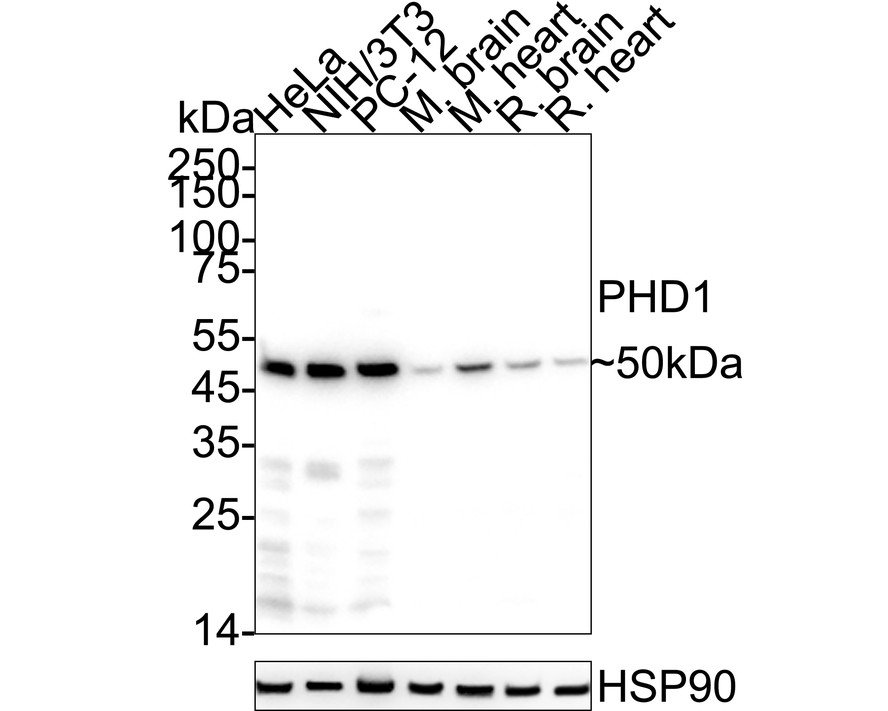
|
Fig1:
Western blot analysis of PHD1 / prolyl hydroxylase on different lysates with Rabbit anti-PHD1 / prolyl hydroxylase antibody (ET1604-5) at 1/1,000 dilution. Lane 1: HeLa cell lysate (20 µg/Lane) Lane 2: NIH/3T3 cell lysate (20 µg/Lane) Lane 3: PC-12 cell lysate (20 µg/Lane) Lane 4: Mouse brain tissue lysate (40 µg/Lane) Lane 5: Mouse heart tissue lysate (40 µg/Lane) Lane 6: Rat brain tissue lysate (40 µg/Lane) Lane 7: Rat heart tissue lysate (40 µg/Lane) Predicted band size: 44 kDa Observed band size: 50 kDa Exposure time: 10 seconds; ECL: K1801; 4-20% SDS-PAGE gel. Proteins were transferred to a PVDF membrane and blocked with 5% NFDM/TBST for 1 hour at room temperature. The primary antibody (ET1604-5) at 1/1,000 dilution was used in 5% NFDM/TBST at 4℃ overnight. Goat Anti-Rabbit IgG - HRP Secondary Antibody (HA1001) at 1/50,000 dilution was used for 1 hour at room temperature. |
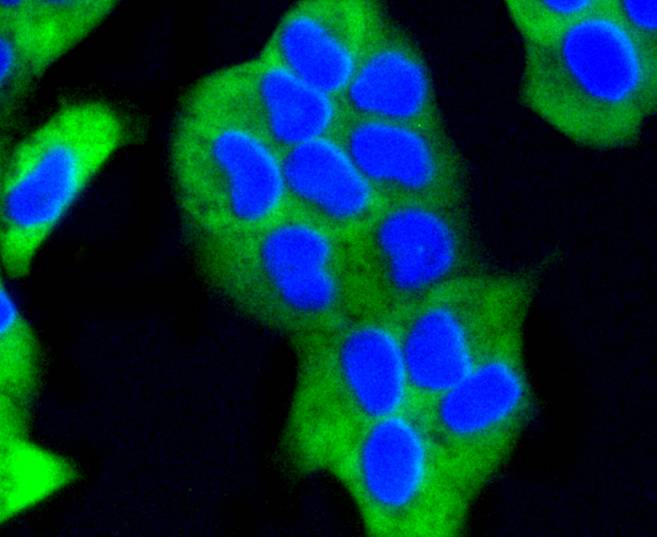
|
Fig2: ICC staining of PHD1 / prolyl hydroxylase in Hela cells (green). Formalin fixed cells were permeabilized with 0.1% Triton X-100 in TBS for 10 minutes at room temperature and blocked with 1% Blocker BSA for 15 minutes at room temperature. Cells were probed with the primary antibody (ET1604-5, 1/50) for 1 hour at room temperature, washed with PBS. Alexa Fluor®488 Goat anti-Rabbit IgG was used as the secondary antibody at 1/1,000 dilution. The nuclear counter stain is DAPI (blue). |

|
Fig3: ICC staining of PHD1 / prolyl hydroxylase in A549 cells (green). Formalin fixed cells were permeabilized with 0.1% Triton X-100 in TBS for 10 minutes at room temperature and blocked with 1% Blocker BSA for 15 minutes at room temperature. Cells were probed with the primary antibody (ET1604-5, 1/50) for 1 hour at room temperature, washed with PBS. Alexa Fluor®488 Goat anti-Rabbit IgG was used as the secondary antibody at 1/1,000 dilution. The nuclear counter stain is DAPI (blue). |
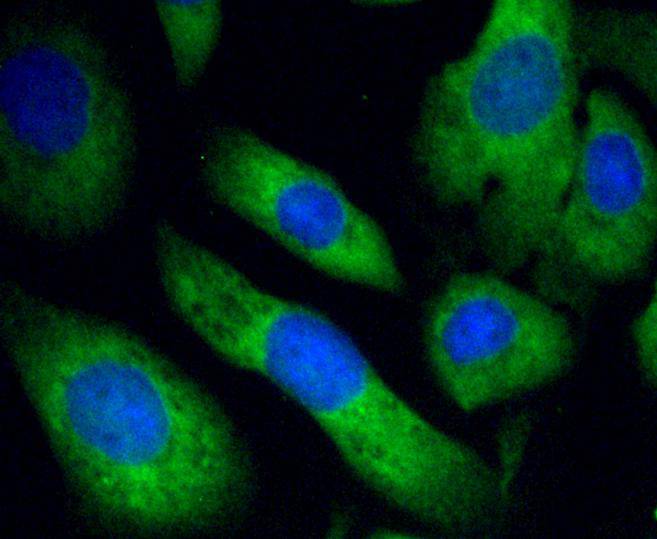
|
Fig4: ICC staining of PHD1 / prolyl hydroxylase in SKOV-3 cells (green). Formalin fixed cells were permeabilized with 0.1% Triton X-100 in TBS for 10 minutes at room temperature and blocked with 1% Blocker BSA for 15 minutes at room temperature. Cells were probed with the primary antibody (ET1604-5, 1/50) for 1 hour at room temperature, washed with PBS. Alexa Fluor®488 Goat anti-Rabbit IgG was used as the secondary antibody at 1/1,000 dilution. The nuclear counter stain is DAPI (blue). |
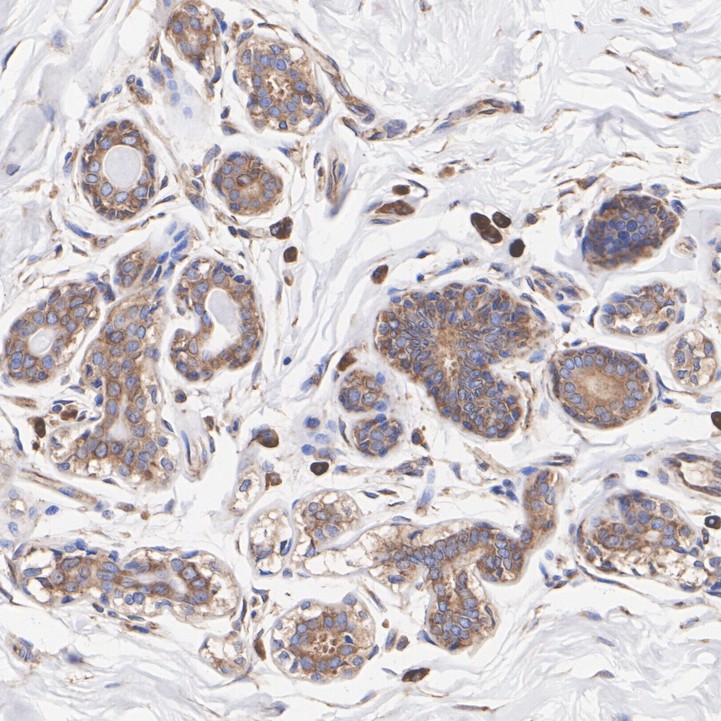
|
Fig5:
Immunohistochemical analysis of paraffin-embedded human breast cancer tissue with Rabbit anti-PHD1 / prolyl hydroxylase antibody (ET1604-5) at 1/1,000 dilution. The section was pre-treated using heat mediated antigen retrieval with Tris-EDTA buffer (pH 9.0) for 20 minutes. The tissues were blocked in 1% BSA for 20 minutes at room temperature, washed with ddH2O and PBS, and then probed with the primary antibody (ET1604-5) at 1/1,000 dilution for 1 hour at room temperature. The detection was performed using an HRP conjugated compact polymer system. DAB was used as the chromogen. Tissues were counterstained with hematoxylin and mounted with DPX. |
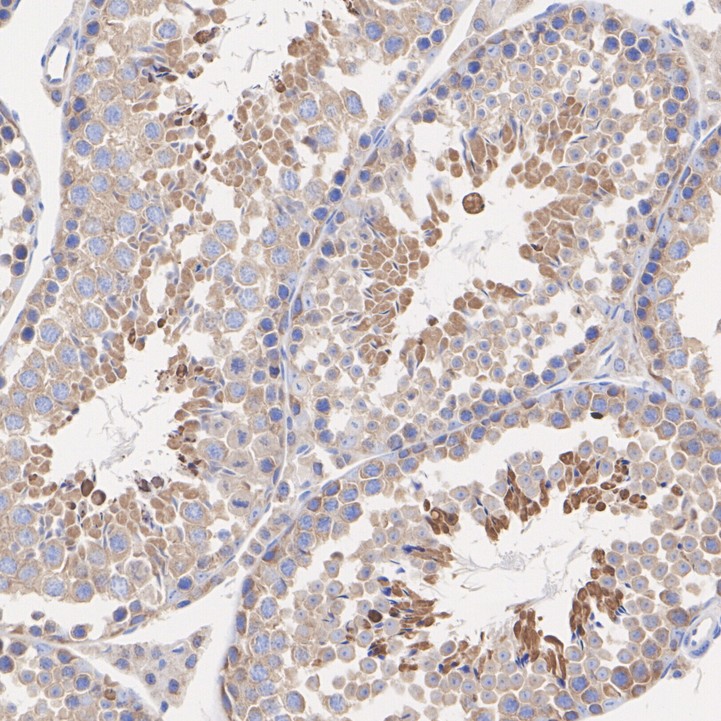
|
Fig6:
Immunohistochemical analysis of paraffin-embedded mouse testis tissue with Rabbit anti-PHD1 / prolyl hydroxylase antibody (ET1604-5) at 1/1,000 dilution. The section was pre-treated using heat mediated antigen retrieval with Tris-EDTA buffer (pH 9.0) for 20 minutes. The tissues were blocked in 1% BSA for 20 minutes at room temperature, washed with ddH2O and PBS, and then probed with the primary antibody (ET1604-5) at 1/1,000 dilution for 1 hour at room temperature. The detection was performed using an HRP conjugated compact polymer system. DAB was used as the chromogen. Tissues were counterstained with hematoxylin and mounted with DPX. |
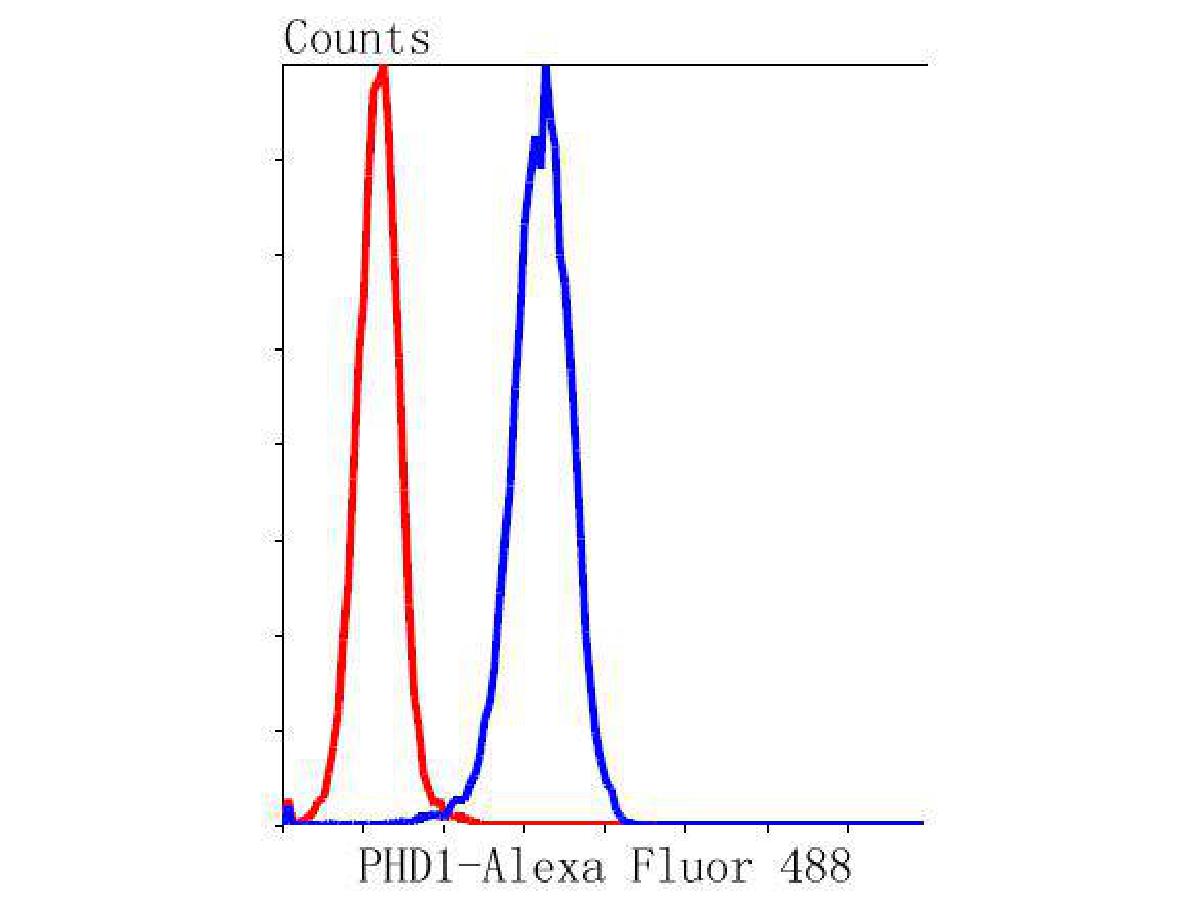
|
Fig7: Flow cytometric analysis of PHD1 / prolyl hydroxylase was done on Hela cells. The cells were fixed, permeabilized and stained with the primary antibody (ET1604-5, 1/50) (blue). After incubation of the primary antibody at room temperature for an hour, the cells were stained with a Alexa Fluor 488-conjugated Goat anti-Rabbit IgG Secondary antibody at 1/1000 dilution for 30 minutes.Unlabelled sample was used as a control (cells without incubation with primary antibody; red). |
Note: All products are “FOR RESEARCH USE ONLY AND ARE NOT INTENDED FOR DIAGNOSTIC OR THERAPEUTIC USE”.